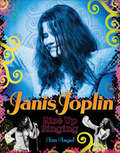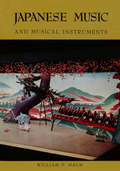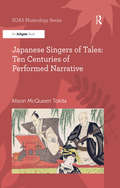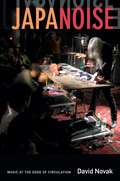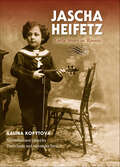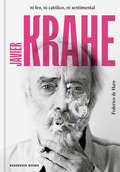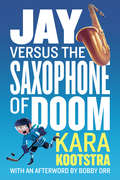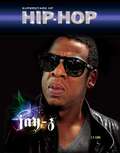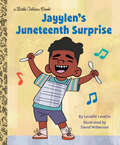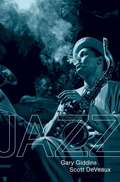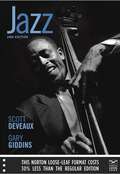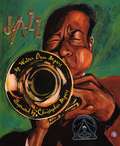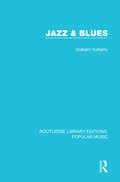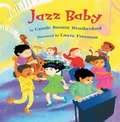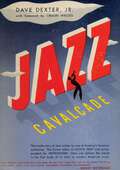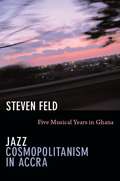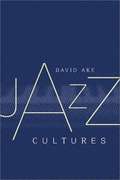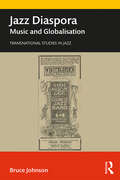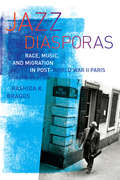- Table View
- List View
Janis Joplin: Rise Up Singing
by Ann AngelForty years after her death, Janis Joplin remains among the most compelling and influential figures in rock-and-roll history. Her story—told here with depth and sensitivity by author Ann Angel—is one of a girl who struggled against rules and limitations, yet worked diligently to improve as a singer. It’s the story of an outrageous rebel who wanted to be loved, and of a wild woman who wrote long, loving letters to her mom. And finally, it’s the story of one of the most iconic female musicians in American history, who died at twenty-seven. Janis Joplin includes more than sixty photographs, and an assortment of anecdotes from Janis’s friends and band mates. This thoroughly researched and well-illustrated biography is a must-have for all young artists, music lovers, and pop-culture enthusiasts.
Janis: Her Life and Music
by Holly George-WarrenLonglisted for the 2020 Andrew Carnegie Medals for Excellence This blazingly intimate biography of Janis Joplin establishes the Queen of Rock & Roll as the rule-breaking musical trailblazer and complicated, gender-bending rebel she was.Janis Joplin’s first transgressive act was to be a white girl who gained an early sense of the power of the blues, music you could only find on obscure records and in roadhouses along the Texas and Louisiana Gulf Coast. But even before that, she stood out in her conservative oil town. She was a tomboy who was also intellectually curious and artistic. By the time she reached high school, she had drawn the scorn of her peers for her embrace of the Beats and her racially progressive views. Her parents doted on her in many ways, but were ultimately put off by her repeated acts of defiance. Janis Joplin has passed into legend as a brash, impassioned soul doomed by the pain that produced one of the most extraordinary voices in rock history. But in these pages, Holly George-Warren provides a revelatory and deeply satisfying portrait of a woman who wasn’t all about suffering. Janis was a perfectionist: a passionate, erudite musician who was born with talent but also worked exceptionally hard to develop it. She was a woman who pushed the boundaries of gender and sexuality long before it was socially acceptable. She was a sensitive seeker who wanted to marry and settle down—but couldn’t, or wouldn’t. She was a Texan who yearned to flee Texas but could never quite get away—even after becoming a countercultural icon in San Francisco. Written by one of the most highly regarded chroniclers of American music history, and based on unprecedented access to Janis Joplin’s family, friends, band mates, archives, and long-lost interviews, Janis is a complex, rewarding portrait of a remarkable artist finally getting her due.
Japanese Music and Musical Instruments
by William P. MalmMr. Malm makes available in this interesting and authoritative book the essential facts about the various forms of Japanese music and musical instruments and their place in the overall history of Japan. The book has three main orientations: the history of Japanese music, construction of the instruments, and analysis of the music itself. The book covers in a lucidly written text and a wealth of fascinating photographs and drawings the main forms of musical expression. Many readers will find the useful hints on purchasing instruments, records, and books especially valuable, and for those who wish to pursue the matter further there is a selected bibliography and a guide to Tokyo's somewhat hidden world of Japanese music. It will be found an invaluable aid to the understanding and appreciation of an important, but little-known, and fascinating aspect of Japanese culture.
Japanese Popular Music: Culture, Authenticity and Power (Media, Culture and Social Change in Asia #Vol. 9)
by Carolyn S. StevensJapanese popular culture has been steadily increasing in visibility both in Asia and beyond in recent years. This book examines Japanese popular music, exploring its historical development, technology, business and production aspects, audiences, and language and culture. Based both on extensive textual and aural analysis, and on anthropological fieldwork, it provides a wealth of detail, finding differences as well as similarities between the Japanese and Western pop music scenes. Carolyn Stevens shows how Japanese popular music has responded over time to Japan's relationship to the West in the post-war era, gradually growing in independence from the political and cultural hegemonic presence of America. Similarly, the volume explores the ways in which the Japanese artist has grown in independence vis-à-vis his/her role in the production process, and examines in detail the increasingly important role of the jimusho, or the entertainment management agency, where many individual artists and music industry professionals make decisions about how the product is delivered to the public. It also discusses the connections to Japanese television, film, print and internet, thereby providing through pop music a key to understanding much of Japanese popular culture more widely.
Japanese Singers of Tales: Ten Centuries Of Performed Narrative (SOAS Musicology Series)
by Alison McQueen TokitaAlison McQueen Tokita presents a series of case studies that demonstrate the persistence of Japanese sung narratives in a multiplicity of genres over ten centuries, including the way they flourished and declined, together with factors contributing to development and change in narrative performance. Performed narratives are examples of a shared cultural heritage, which in the past have given people a sense of belonging to a community. Narratives that were continually re-told and recycled in different versions and formats over a long period of time served to build people's sense of a common identity over space (the geographical extent of 'Japan') and time (the enduring power of many specific narratives such as The Tale of the Heike). Much scholarly attention has focused on Japanese pre-modern literature and drama, but the tradition of oral narrative has barely been touched. Tokita argues that it is possible to identify a continuous tradition of performed narrative in Japan from the tenth to the twentieth centuries. The elements of variation and change relate to the move away from oral narrative to text-based performance, and from a simple narrative situation with one performer to complex theatrical narratives with dancers, singers and other musicians. The resulting complexity led to the pre-eminence of the musical aspects in some cases, and of dramatic or dance aspects in others. Tokita includes substantial musical analysis and exploration of theoretical issues, as well as documentation of important performance traditions, all of which are extant.
Japanoise: Music at the Edge of Circulation
by David NovakNoise, an underground music made through an amalgam of feedback, distortion, and electronic effects, first emerged as a genre in the 1980s, circulating on cassette tapes traded between fans in Japan, Europe, and North America. With its cultivated obscurity, ear-shattering sound, and over-the-top performances, Noise has captured the imagination of a small but passionate transnational audience. For its scattered listeners, Noise always seems to be new and to come from somewhere else: in North America, it was called "Japanoise. " But does Noise really belong to Japan? Is it even music at all? And why has Noise become such a compelling metaphor for the complexities of globalization and participatory media at the turn of the millennium? In Japanoise, David Novak draws on more than a decade of research in Japan and the United States to trace the "cultural feedback" that generates and sustains Noise. He provides a rich ethnographic account of live performances, the circulation of recordings, and the lives and creative practices of musicians and listeners. He explores the technologies of Noise and the productive distortions of its networks. Capturing the textures of feedback--its sonic and cultural layers and vibrations--Novak describes musical circulation through sound and listening, recording and performance, international exchange, and the social interpretations of media.
Jascha Heifetz: Early Years in Russia (Russian Music Studies)
by Galina KopytovaNotoriously reticent about his early years, violinist Jascha Heifetz famously reduced the story of his childhood to "Born in Russia. First lessons at 3. Debut in Russia at 7. Debut in Carnegie Hall at 17. That's all there is to say." Tracing his little-known upbringing, Jascha Heifetz: Early Years in Russia uncovers the events and experiences that shaped one of the modern era's most unique talents and enigmatic personalities. Using previously unstudied archival materials and interviews with family and friends, this biography explores Heifetz's meteoric rise in the Russian music world—from his first violin lessons with his father, to his studies at the St. Petersburg Conservatory with the well-known pedagogue Leopold Auer, to his tours throughout Russia and Europe. Spotlighting Auer's close-knit circle of musicians, Galina Kopytova underscores the lives of artists in Russia's "Silver Age"—an explosion of artistic activity amid the rapid social and political changes of the early 20th century.
Javier Krahe. Ni feo, ni católico, ni sentimental
by Federico de HaroLa primera biografía de Javier Krahe, el bardo más irreverente e inclasificable de la canción española. Javier Krahe, como él mismo solía decir, añadió una varilla nueva al abanico del género canción en nuestro país. Con ella, el aire circula con una fuerza literaria insólita y descubre rincones inexplorados. Conocido sobre todo por sus letras cáusticas sobre el amor, la política y la religión, admirador de Brassens y de Leonard Cohen, colega de Chicho Sánchez Ferlosio y mentor de Joaquín Sabina y Albert Pla, tuvo una vida inquieta (a su manera) y curiosa. Tanto como sus canciones, que hunden sus raíces en los años de estudiante en El Pilar y llegan hasta las fecundas temporadas en Zahara de los Atunes, pasando por el dulce autoexilio canadiense en el franquismo tardío, los primeros años de la democracia y los posteriores encontronazos con el poder. Canciones como «La hoguera», «Marieta», «Un burdo rumor», «Cuervo ingenuo», «En la costa suiza» o «No todo va a ser follar» son bandera de la contracultura más duradera. Federico de Haro ha reconstruido la vida y la carrera de Javier Krahe a partir de los dos ingredientes imprescindibles en toda gran biografía: pasión y fuentes. La familia y los amigos del cantautor han abierto las puertas de sus casas para contarle todo lo que no se sabe sobre Krahe. El relato, completado con un examen cercano de su personal manera de componer las canciones e introducirlas en directo y con un apéndice con sus primeras letras (inéditas hasta hoy) da como resultado un retrato íntimo y original del hombre que siempre anduvo a la contra. Prólogo de Julio LlamazaresEpílogo de Javier López de Guereña Reseñas:«En este libro está Krahe tal como yo lo quise y lo conocí. Nadie ha amado tanto las palabras cantadas como mi hermano Javier y el autor de este libro lo sabe y se lo hace saber a sus lectores, que ojalá sean los que se merece. Porque a Krahe hay que merecerlo. Merézcanlo ustedes y serán recompensados con la magia de una lengua, la nuestra, que en sus dedos y en su voz era por lo menos como el francés de Georges Brassens.»Joaquín Sabina «La vida de Javier Krahe, que está en sus canciones pero también oculta detrás de ellas (hay que saber cuándo dice la verdad y cuándo miente), está contada por Federico de Haro con tanta inteligencia y admiración que ni una ni otra se notan apenas [...] La verdad, lo ha hecho con tanta elegancia y respeto que a veces hasta cuesta saber si es Krahe o el biógrafo el que habla, tal ha sido la simbiosis de pensamiento y de palabra entre los dos. Lo mejor que se puede decir de esta biografía, evangelio o recensión apócrifa es que a Krahe le habría gustado mucho leerla.»Julio Llamazares «Bendito sea el Krahe; y quien le ha glosado con tanto acierto, Federico de Haro.»Javier López de Guereña
Jay Versus the Saxophone of Doom
by Bobby Orr Kara Kootstra Kim SmithWho knew grade six music could be so scary? For kids who love The Diary of a Wimpy Kid and The Dork Diaries comes a hilarious new entry into funny middle-grade novels.Jay Roberts loves hockey. He's good at it. He also loves his hockey hero, Bobby Orr, considered a legend by Jay's grandfather. In fact, even though they may bicker, when it comes to the Bruins, the whole family agrees that they are the team to root for. When it comes to hockey, Jay's a team player, but there's one person who seems determined to make life hard for Jay: his classmate and fellow team member, Mick Bartlet. It's a good thing Jay can usually stickhandle his way out of his bullying. But something else is determined to make Jay's life difficult, something far harder for Jay to play: the saxophone.Sixth grade just became a whole lot more challenging ...From the Hardcover edition.
Jay-Z (Superstars of Hip-Hop)
by C. F. EarlJay-Z is one of hip-hop's biggest stars. The New York rapper has been successful in music for more than 15 years. His albums have sold millions and he's won many awards for his work. Jay's also found success in the business of hip-hop, too. His companies Roca Wear and Roc-Nation have been hugely successful. With Watch the Throne, Jay continues to make great music fans love. Jay-Z is the story of how Jay went from selling drugs to selling records. Read about how Jay made smart decisions early on in his career and how he's stayed successful ever since.
Jayylen's Juneteenth Surprise (Little Golden Book)
by Lavaille LavetteCreated in partnership with Ebony Jr., this inspiring Little Golden Book tells the story of one young boy's first experience celebrating Juneteenth.When Jayylen's grandfather, Paw Paw Jimmy, begins preparing for a big Juneteenth celebration, Jayylen has a lot of questions. Most importantly, what is Juneteenth? His mother and Paw Paw Jimmy explain that the holiday marks the anniversary of when enslaved African Americans found out that they were free. Paw Paw Jimmy plays some zydeco for him, which is the type of music they will dance to at the celebration. Jayylen practices every day so that he will be able to play the frottoir (a percussion instrument similar to a washboard) for everyone. But will he be able to pull off an even bigger surprise for the day?Since 1945, Ebony magazine has shined a spotlight on the worlds of Black people in America and worldwide, telling their stories. Ebony Jr! was created in 1973 to give Black children a magazine that was all their own. The magazine included stories, comics, puzzles, and cartoons centering Black children. Its mission was to ignite a love of reading and a love of self in Black kids, and we&’re continuing that with our LGB program.
Jazz
by Gary Giddins Scott DeveauxIn this vivid history of jazz, a respected critic and a leading scholar capture the excitement of America's unique music with intellectual bite, unprecedented insight, and the passion of unabashed fans. They explain what jazz is, where it came from, and who created it and why, all within the broader context of American life and culture. Emphasizing its African American roots, Jazz traces the history of the music over the last hundred years. From ragtime and blues to the international craze for swing, from the heated protests of the avant-garde to the radical diversity of today's artists, Jazz describes the travails and triumphs of musical innovators struggling for work, respect, and cultural acceptance set against the backdrop of American history, commerce, and politics. With vibrant photographs by legendary jazz chronicler Herman Leonard, Jazz is also an arresting visual history of a century of music.
Jazz
by Gary Giddins Scott DeVeauxAll That Jazz―Total Access to the music and the players. This streamlined second edition exposes students to the expressive power of jazz and brings its greatest players to life. With an emphasis on engagement with the music, this new text gives students all the guidance and inspiration they need to fully understand jazz. Now with Total Access, Jazz offers students a package without match―streaming music of 77 classic masterpieces and little-known gems, robust Listening Guides, a media-rich ebook, outstanding video, and a gripping narrative―all at an unbeatable price.
Jazz
by Walter Dean MyersFather and son team Walter Dean Myers, author, and Christopher Myers, illustrator, create a book of rhyming text and illustrations which celebrate the roots of jazz music.
Jazz & Blues (Routledge Library Editions: Popular Music #4)
by Graham VulliamyThis book, first published in 1982, shows that jazz and blues are music forms that are about individualism, experiment, expression and feeling. From their origin in the work songs and spirituals of America’s southern slaves, through to their adaptation to the urban adaptation to the urban environment in Chicago and New Orleans, the author details the social and economic background that saw the birth of the blues and jazz, and introduces and appraises their leading exponents. He shows how African rhythms were combined with an American musical tradition to produce a distinctive style which was to revitalise Western music.
Jazz (History of American Music, Ninth Edition)
by Paul O. W. Tanner David W. Megill Maurice GerowThe Ninth Edition of Jazz takes students on an extraordinary musical journey through the changing styles and the fascinating history of jazz. With a strong emphasis on listening and an outstanding photo program, Jazz offers an insider's view of the most important music, artists, clubs, and precursors in jazz history. New to the Ninth Edition, personal accounts by major players in the scene -- "Witness to Jazz" -- take students inside the sessions, giving them a firsthand view of the lively context surrounding the growth of this uniquely American art form.
Jazz Among the Discourses
by Krin GabbardThe study of jazz comes of age with this anthology. One of the first books to consider jazz outside of established critical modes, Jazz Among the Discourses brings together scholars from an array of disciplines to question and revise conventional methods of writing and thinking about jazz.Challenging "official jazz histories," the contributors to this volume view jazz through the lenses of comparative literature; African American studies; music, film, and communication theory; English literature; American studies; history; and philosophy. With uncommon rigor and imagination, their essays probe the influence of various discourses--journalism, scholarship, politics, oral history, and entertainment--on writing about jazz. Employing modes of criticism and theory that have transformed study in the humanities, they address questions seldom if ever raised in jazz writing: What are the implications of building jazz history around the medium of the phonograph record? Why did jazz writers first make the claim that jazz is an art? How is an African American aesthetic articulated through the music? What are the consequences of the interaction between the critic and the jazz artist? How does the improvising artist navigate between chaos and discipline?Along with its companion volume, Representing Jazz, this versatile anthology marks the arrival of jazz studies as a mature, intellectually independent discipline. Its rethinking of conventional jazz discourse will further strengthen the position of jazz studies within the academy.Contributors. John Corbett, Steven B. Elworth, Krin Gabbard, Bernard Gendron, William Howland Kenney, Eric Lott, Nathaniel Mackey, Burton Peretti, Ronald M. Radano, Jed Rasula, Lorenzo Thomas, Robert Walser
Jazz Baby, First Edition
by Carole Boston WeatherfordA group of toddlers move and play, hum and sleep to a jazz beat.
Jazz Cavalcade: The Inside Story of Jazz
by Dave Dexter JrThe inside story of Jazz written by one of America's foremost authorities. The former editor of DOWN BEAT and correspondent for METRONOME takes you behind the scenes in the first book of its kind on modern American music.“Dave Dexter's Jazz Cavalcade is just about the best stuff I have ever read on the subject. Of all the writer-editors, Dexter is the most accurate, unprejudiced, and blessed with background.”—BENNY GOODMANDavid Edwin Dexter Jr. (November 25, 1915 – April 19, 1990) was an American music journalist, record company executive, and producer known primarily for his long association with Capitol Records. He worked with many important figures in jazz and traditional popular music, including Count Basie, Peggy Lee, Duke Ellington, and Frank Sinatra.
Jazz Cosmopolitanism in Accra: Five Musical Years in Ghana
by Steven FeldIn this remarkable book, Steven Feld, pioneer of the anthropology of sound, listens to the vernacular cosmopolitanism of jazz players in Ghana. Some have traveled widely, played with American jazz greats, and blended the innovations of John Coltrane with local instruments and worldviews. Combining memoir, biography, ethnography, and history, Feld conveys a diasporic intimacy and dialogue that contests American nationalist and Afrocentric narratives of jazz history. His stories of Accra's jazz cosmopolitanism feature Ghanaba/Guy Warren (1923-2008), the eccentric drummer who befriended the likes of Charlie Parker, Max Roach, and Thelonious Monk in the United States in the 1950s, only to return, embittered, to Ghana, where he became the country's leading experimentalist. Others whose stories figure prominently are Nii Noi Nortey, who fuses the legacies of the black avant-gardes of the 1960s and 1970s with pan-African philosophy in sculptural shrines to Coltrane and musical improvisations inspired by his work; the percussionist Nii Otoo Annan, a traditional master inspired by Coltrane's drummers Elvin Jones and Rashied Ali; and a union of Accra truck and minibus drivers whose squeeze-bulb honk-horn music for drivers' funerals recalls the jazz funerals of New Orleans. Feld describes these artists' cosmopolitan outlook as an "acoustemology," a way of knowing the world through sound.
Jazz Cultures
by David AkeAke examines the musical identities and styles of several jazz musicians, some canonical and some not, to illuminate how and why identities and styles contribute to the making of the jazz canon.
Jazz Diaspora: Music and Globalism
by Bruce JohnsonJazz Diaspora: Music and Globalism is about the international diaspora of jazz, well underway within a year of the first jazz recordings in 1917. This book studies the processes of the global jazz diaspora and its implications for jazz historiography in general, arguing for its relevance to the fields of sonic studies and cognitive theory. Until the late twentieth century, the historiography and analysis of jazz were centred on the US to the almost complete exclusion of any other region. The driving premise of this book is that jazz was not ‘invented’ and then exported: it was invented in the process of being disseminated. Jazz Diaspora is a sustained argument for an alternative historiography, based on a shift from a US-centric to a diasporic perspective on the music. The rationale is double-edged. It appears that most of the world’s jazz is experienced (performed and consumed) in diasporic sites – that is, outside its agreed geographical point of origin – and to ignore diasporic jazz is thus to ignore most jazz activity. It is also widely felt that the balance has shifted, as jazz in its homeland has become increasingly conservative. There has been an assumption that only the ‘authentic’ version of the music--as represented in its country of origin--was of aesthetic and historical interest in the jazz narrative; that the forms that emerged in other countries were simply rather pallid and enervated echoes of the ‘real thing’. This has been accompanied by challenges to the criterion of place- and race-based authenticity as a way of assessing the value of popular music forms in general. As the prototype for the globalisation of popular music, diasporic jazz provides a richly instructive template for the study of the history of modernity as played out musically.
Jazz Diasporas
by Rashida K. BraggsAt the close of the Second World War, waves of African American musicians migrated to Paris, eager to thrive in its reinvigorated jazz scene. Jazz Diasporas challenges the notion that Paris was a color-blind paradise for African Americans. On the contrary, musicians adopted a variety of strategies to cope with the cultural and social assumptions that confronted them throughout their careers in Paris, particularly as France became embroiled in struggles over race and identity when colonial conflicts like the Algerian War escalated. Using case studies of prominent musicians and thoughtful analysis of interviews, music, film, and literature, Rashida K. Braggs investigates the impact of this postwar musical migration. She examines key figures including musicians Sidney Bechet, Inez Cavanaugh, and Kenny Clarke and writer and social critic James Baldwin to show how they performed both as artists and as African Americans. Their collaborations with French musicians and critics complicated racial and cultural understandings of who could represent "authentic" jazz and created spaces for shifting racial and national identities--what Braggs terms "jazz diasporas."
Jazz Diplomacy: Promoting America in the Cold War Era (American Made Music Series)
by Lisa E. DavenportJazz as an instrument of global diplomacy transformed superpower relations in the Cold War era and reshaped democracy's image worldwide. Lisa E. Davenport tells the story of America's program of jazz diplomacy practiced in the Soviet Union and other regions of the world from 1954 to 1968. Jazz music and jazz musicians seemed an ideal card to play in diminishing the credibility and appeal of Soviet communism in the Eastern bloc and beyond. Government-funded musical junkets by such jazz masters as Louis Armstrong, Dave Brubeck, Duke Ellington, Dizzy Gillespie, and Benny Goodman dramatically influenced perceptions of the U.S. and its capitalist brand of democracy while easing political tensions in the midst of critical Cold War crises. This book shows how, when coping with foreign questions about desegregation, the dispute over the Berlin Wall, the Cuban missile crisis, Vietnam, and the Soviet invasion of Czechoslovakia, jazz players and their handlers wrestled with the inequalities of race and the emergence of class conflict while promoting America in a global context. And, as jazz musicians are wont to do, many of these ambassadors riffed off script when the opportunity arose. Jazz Diplomacy argues that this musical method of winning hearts and minds often transcended economic and strategic priorities. Even so, the goal of containing communism remained paramount, and it prevailed over America's policy of redefining relations with emerging new nations in Africa, Asia, and Latin America.
Jazz Guitar Licks: 25 Licks from the Harmonic Minor Scale & its Modes with Audio & Video (Jazz Guitar Licks #2)
by Gareth Evans25 original jazz guitar licks from the Harmonic minor scale and its modes in tablature and notation. >> 120 bars of music over 25 licks (average lick length 4.8 bars) >> Video at full speed & Audio at full & half speed (Downloadable) >> Backing tracks at full and slower practise speeds (Downloadable) >> Scale diagrams with theory and technique tips for each lick >> Guitar tablature has picking directions & fretting finger guide numbers Please Note: This eBook has written music and is not suitable for smaller screens.
